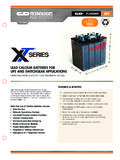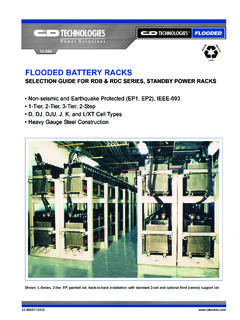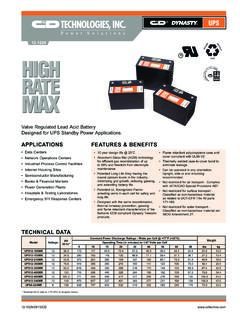Transcription of Charging Valve Regulated Lead Acid Batteries
1 Charging Valve RegulatedLead acid Batteries41-2128 TECHNICAL BULLETIN41-2128/0212/CD Note: The information in this technical bulletin was developed for C&D Dynasty 12 Volt VRLA much of the information herein is general, larger 2 Volt VRLA products are not within the intended of ContentsCHARGING Valve Regulated LEAD acid BATTERIESV alve Regulated Lead acid Batteries 20 to 200 Ampere Hours Lead acid Battery Theory of OperationDischarge and Charging ReactionsOverchargingVented Lead acid Cells: Overcharging and GassingValve Regulated Lead acid (VRLA) Cells: Overcharging and Gassing Lead acid Batteries and UnderchargingCharging the Valve Regulated Lead acid (VRLA) BatteryConstant Current ChargingSingle Rate Constant Current ChargingMulti-Rate Constant Current ChargingTaper Current ChargingConstant Voltage - Unlimited Current ChargingModified Constant Voltage-Limited Current ChargingCharging Voltages vs.
2 Electrolyte Specific Gravity (SG)Recharging Time vs. Charging Voltage and Depth of Discharge (DOD) Temperature Rise vs. Charging Voltage and Depth of DischargeCurrent Limit and Depth of Discharge (DOD) vs. Recharge Time and Temperature Charging Voltage vs. GassingCharging Voltage vs. Current AcceptanceCurrent Acceptance vs. Battery TemperatureVRLA Battery Float Voltage and Temperature CompensationCharger DC Output and AC Ripple Voltage and CurrentThermal Runaway and VRLA Battery ChargingCharging Parallel Strings of VRLA BatteriesSummary of Charging Methods for Valve Regulated Lead acid Batteries Criterion for Charging VRLA Batteries in Float (Standby) Service:Typical Float Charging TechniquesSummary41-2128/0212/CD 2 3 33456 678911121415 151718202122 222324252628293141-2128/0212/CD 3 Regulated Lead acid Batteries20 to 200 Ampere HoursLead acid Battery Theory of OperationDischarge and Charging ReactionsThe lead acid battery is a truly unique device - an assembly of the active materials of a lead dioxide(PbO2) positive plate, sulfuric acid (H2SO4) electrolyte and a sponge (porous)
3 Lead (Pb) negative platewhich, when a load is connected between the positive and negative terminals, an electrochemical reaction occurs within the cell which will produce electrical energy (current) through the load as theseactive materials are converted to lead sulfate (H2SO4) and water (H2O). When the load is removedand replaced by an appropriate DC current source, electrical energy ( Charging current) will flowthrough the battery in the opposite direction converting the active materials to their original states oflead dioxide, sulfuric acid and lead. This "recharging" of the battery restores the potential energy,making it again available to produce the electrical current during a subsequent discharge. This reversibleelectrochemical process is illustrated in Equations 1, 2 and PbO2+ 2 H2SO4+ Pb = PbSO4+ 2H2O + PbSO42.
4 Reaction at the Positive Plate PbO2+ 4H++ SO4+ 2e-= 2H2O + PbSO43. Reaction at the Negative Plate Pb + SO4= PbSO4+ 2e-In theory, this discharge and recharge process could continue indefinitely were it not for the corrosionof the grids onto which the lead dioxide (PbO2) and lead (Pb) active materials are pasted, deterioration ofthe lead dioxide and sponge lead active materials of the positive and negative plates, and in the caseof VRLA Batteries , drying of the electrolyte. While internal local action and deep discharge do play aroll in grid corrosion and active material deterioration, and elevated operating temperatures do furtheraggravate the situation, it is most often that improper Charging techniques are primarily responsiblefor premature battery only requires between 107% and 115% of the ampere hours energy removed from a lead acid battery to be restored to achieve a fully charged system capable of delivering 100% of its rated capacity.
5 For example, if 10 ampere hours of energy had been removed from a battery during discharge, then ampere hours of energy would have to be replaced through the Charging activityto restore 100% of capacity. Charging at too high a rate or forcing more than the 107% required intothe battery constitutes overcharging and results in additional grid corrosion, gassing and consumptionof the water in the electrolyte. This overcharging is a common cause of premature battery Lead acid Cells: Overcharging and GassingOnce the plates of the battery are fully converted to their original lead dioxide (PbO2) in the positiveplate and sponge lead (Pb) in the negative plate, most of the additional ampere-hours or chargingcurrent are consumed in the electrolysis of the water in the electrolyte. In the vented (flooded) cell,this occurs at the positive and negative plates as shown in Equations 4, 5 and Positive PlateH2O - 2e-= 1/2 O2+ 2H+5.
6 Negative Plate2H++ 2e-= H26. Net ReactionH2O = H2+ 1/2 O241-2128/0212/CD 4 5 shown in Equation 8, the water (H2O) in the electrolyte at the positive plate is broken down intooxygen gas (O2), free hydrogen ions (4H+) and free electrons (4e-). The free electrons are "pulled"from the positive plate by the connected charger and "pumped" to the negative plate as noted inEquation 5. As the free hydrogen ions (4H+) migrate through the electrolyte and contact the negativeplate, where there is an excess of electrons, the hydrogen ions take on an electron, and hydrogengas (2H2) is formed.
7 Being a vented cell with liquid electrolyte, the oxygen gas (O2) generated at thepositive plate and the hydrogen gas (2H2) generated at the negative plate will percolate up throughthe electrolyte and into the surrounding atmosphere as the electrolyte level declines. Since the waterthat is gassed off can be replaced, this consequence of overcharging with have little impact on the lifeof the vented Regulated Lead acid (VRLA) Cells: Overcharging and GassingThe VRLA battery is unique in that its electrolyte is immobilized and each cell contains a one way selfresealing Valve in the vent. The combination of these two features facilitate an oxygen recombinationcycle which, under normal circumstances, will prevent the regular emission of gases and the need toreplenish the electrolyte water supply.
8 The electrolyte water is decomposed at the positive plate in thesame manner as the vented (flooded) cell. See Equation 7:7. H2O = H2+ 1/2 0241-2128/0212/CD 6 , because the electrolyte is immobilized in a porous medium, such as an absorbent glassmat (AGM) separator that contains void spaces, the oxygen gas generated at the positive plate willdiffuse through the separator material and contact the negative plate forming lead oxide (PbO) asnoted in Equation Pb + 1/2O2= PbO9. PbO + H2SO4= PbSO4+ H2O10. PbSO4+ 2H++ 4e-= Pb + H2SO4 The lead oxide (PbO) then reacts with the sulfuric acid (H2SO4) in the electrolyte to partially discharge the negative plate forming lead sulfate (PbSO4) and restoring the water (H2O).
9 However, as noted in Equation 11, the lead sulfate of the partially discharged negative reacts with thehydrogen ions (2H+) from the positive plate and the free electrons (4e-) being supplied by the chargerto recharge the negative plate to its original form of lead (Pb) and restore the sulfuric acid (H2SO4) ofthe electrolyte. The net result, provided the rate of overcharge is not excessive, is the generation ofhydrogen gas being suppressed, and there is no net loss of water from the electrolyte-a safer batterythat does not require electrolyte maintenance. However, if the Charging voltage is increased to suchan extent that the resulting Charging current generates the oxygen gas at a rate faster than what itcan diffuse through the separator system, then the cell will revert to operation similar to that of avented cell and will consume water and emit hydrogen.
10 Naturally, this will lead to electrolyte dry-outand premature failure of the acid Batteries and UnderchargingUndercharging of the battery occurs when 107% to 115% of the removed ampere hours are not provided during the recharge. When not fully recharged, the residual lead sulfate (PbSO4) remains onthe positive and negative plates and eventually hardens . With successive cycles of undercharging,the layer of residual lead sulfate becomes thicker, the electrolyte specific gravity decreases, and thebattery cycles down in capacity. In the hardened condition, it may not be possible to convert the residual lead sulfate back into the original lead dioxide, sponge lead and sulfur acid active materials,even with higher voltage Charging efforts. In this case, the battery will suffer a permanent loss in the Valve Regulated Lead acid (VRLA) BatteryThe basic requirement to charge a lead acid battery is to have a DC current source of a voltagehigher than the open circuit voltage of the battery to be charged.












